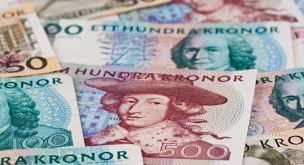12179
0
The currency expert advocate traders to favor Sweden's crown over the US dollar
According to ING analysts, the Swedish krona and the Australian dollar are likely to lead the currency markets through the recovery phase after the corona

Yazar: editor_1
Yayınlanma: 1 Mayıs 2020 20:53
Güncellenme: 26 Aralık 2025 04:19
The currency expert advocate traders to favor Sweden's crown over the US dollar
According to ING analysts, the Swedish krona and the Australian dollar are likely to lead the currency markets through the recovery phase after the coronavirus crisis. As the coronavirus curves gradually flatten out and countries begin to loosen lockdown restrictions that have devastated the global economy, strategists are looking for ways to see which economies could recover first and which may be affected by a hangover from the crisis. Dutch bank ING strategists support "pro-cyclical" currencies that do not have oil exposure to outperform what they consider to be a "U-shaped" recovery. They also believe that the dollar looks vulnerable. Currencies that tend to correlate with economic fluctuations are procyclical currencies. Oil prices have dropped at an unprecedented rate. The corona virus pandemic, which continues to weigh on demand, is causing difficulties for currencies in major exporting countries such as Russia and Nigeria. Chris Turner, Head of Markets at ING Global said on Thursday: "SEK and AUD are both undervalued in our medium-term valuation model, correlate positively with a steeper yield curve in a recovery phase and have no exposure to oil." Above all, ING analysts prefer G-10 currencies (group of 10) over emerging markets in early stages of recovery because a country's financial strength becomes more important. Case for crown Central banks worldwide are fighting the pandemic by aggressively easing their monetary policy to support their economies against the aftermath of the pandemic. A number of countries have lowered interest rates to negative territory, while the Riksbank has kept its repo rate at zero. Due to the lack of exposure to commodity prices, the krone for a "cautious recovery of sentiment against G-10 currencies in the coming months" is in a good position and, according to ING, the most attractive in this group. ING analysts have created a foreign exchange scorecard. The five main factors on which they are based: current valuation, real rates, correlation with the US yield curve, exposure to oil markets and government credit ratings. As of Friday, the krona was trading at around 9.78 against the dollar. The greenback rose 4.6% against the Swedish currency, but the dollar fell more than 2.6% against the crown this week. Aussie bounce The Australian dollar was ranked second by ING. After ING's models have already reduced most losses in the first quarter and have relatively solid fundamentals, it is expected that the group will continue to experience an additional risk recovery. There were several key factors for the Aussie. The first was the federal government's massive $ 320 billion ($ 209.7 billion) government aid package, which accounted for approximately 16% of GDP (gross domestic product). The central bank has already started to stop buying assets. This suggests that economic conditions are improving. "Australia's largest export, iron ore, is proving particularly resilient due to the relatively stable demand from China and the continuing supply shortage from Brazil," said Turner of his note. He also added that the country's previous success in flattening its coronavirus infection curve could further strengthen its recovery prospects. On Friday morning, the Aussie was trading at around 0.645 against the US dollar. It has fallen by more than 8% since the beginning of the year, but has risen by around 0.8% this week. Dollar decline However, the world's most liquid currency, the US dollar, performed poorly on the ING models. "Consistent with our view that the dollar will underperform during a recovery period, our scorecard shows that the dollar is performing poorly in terms of valuation, real interest rates and steeper episodes of the yield curves," wrote Turner. The US dollar currency index has risen by around 2.7% since the beginning of the year and fell by around 1.4% in the past week. The Japanese yen is one of the top FX calls. The flattening of the coronavirus curves, plans to reopen the economies and aggressive measures by monetary and fiscal policy makers have helped lower market risk from its highs in mid to late March.İLGİLİ HABERLER





European stocks soared and focus shifted to German retail sales after Powell's speech!

Forex Signal For TRY/USD: Inflation Slowdown in November.

Forex Signal For GBP/USD: Bullish Trend Still Not Breaking While Recovery Continues.

Forex Signal For EUR/USD: Starry US Data Points to Higher Fed Increases.

Forex Signal For BTC/USD: Downside Continues as Bitcoin Recovery Moves Less.
En Popüler Haberler
Yorum Yap
Yorumlar
Henüz yorum yapan yok! İlk yorumu siz yapın...